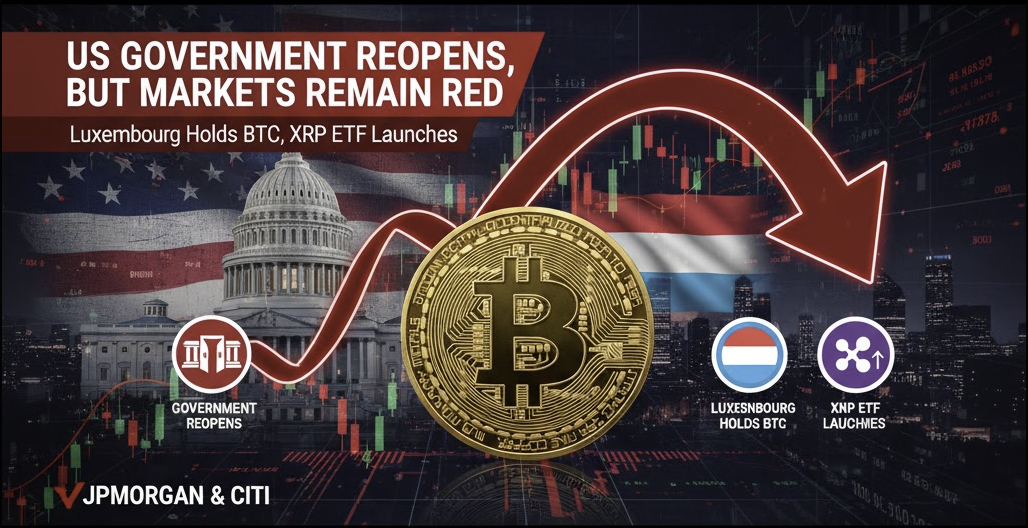Market Overview
On February 12, U.S. equities showed a mixed performance. The Dow Jones and S&P 500 closed lower, while the Nasdaq inched higher. Futures on all three major indexes showed modest gains. Gold surged to a new peak of $2,941 per ounce, while oil prices slightly declined to $70.78 per barrel.

Bitcoin saw rapid fluctuations, dropping before recovering to around $96,000, with mixed performances across major altcoins. The overall crypto market capitalization stood at $3.31 trillion.

Spot Bitcoin ETFs in the U.S. recorded their fourth consecutive session of net outflows, with a massive $251 million exiting the market. This included rare outflows from BlackRock’s IBIT fund. Ethereum spot ETFs also saw $40.9 million in outflows, signaling broader investor caution.

Inflation in the U.S. is Rising Again
The biggest shock to the market came from inflation data. The Consumer Price Index (CPI) for January came in higher than expected, raising concerns about the Federal Reserve’s plans for interest rate cuts. The headline CPI rose 3% year-over-year, exceeding forecasts of 2.8% and accelerating from 2.9% the previous month. Core CPI (excluding food and energy) also surpassed expectations, registering a 3.3% increase, above the 3.1% estimate and up from 3.2% in December.

The persistence of inflation presents a challenge for the Fed, which now faces a difficult balancing act:
- Raising interest rates further could lead to economic contraction or even a recession.
- Holding rates steady may allow inflation to remain stubbornly high.
- Cutting rates too soon could trigger another wave of inflation.
With prices rising across multiple sectors, the data suggests that inflation is proving more persistent than initially expected.

Donald Trump wasted no time in using the numbers for political leverage. On Truth Social, he posted, "Biden Inflation is Rising!", blaming the Biden administration for the latest inflation surge. The argument hinges on the lagging nature of inflation data, which still reflects economic policies from the previous administration.
Historical patterns suggest that short-term inflation spikes can occur within a downward trend, and some analysts remain optimistic that this recent jump is temporary. However, uncertainty remains about how long inflation will stay elevated.
Fed’s Response and Interest Rate Projections
Federal Reserve Chair Jerome Powell testified before Congress, reiterating the Fed’s stance on inflation and monetary policy. He acknowledged that inflation had increased again but offered little indication that rate cuts would happen soon. The Fed remains committed to a "wait-and-see" approach before adjusting policy.

On crypto regulation, Powell reassured that banks are still allowed to serve crypto clients and that the Fed has no intention of obstructing legitimate crypto banking services. He also dismissed speculation that the Fed was working toward launching its own Central Bank Digital Currency (CBDC).
Following Powell’s testimony, expectations for rate cuts shifted. Data from CME’s FedWatch tool now suggests the first rate cut may be delayed until September 2025, instead of the previously anticipated June timeline.
Higher interest rates mean:
- Rising bond yields, making U.S. Treasuries more attractive than riskier assets like equities and crypto.
- Higher borrowing costs, reducing corporate profits and economic expansion.
- Potential capital outflows from crypto and stocks, as investors seek safer returns.
The 10-year Treasury yield climbed higher after the inflation report, signaling that institutional money is shifting toward government bonds. This dynamic exerts downward pressure on both equities and crypto markets.

BlackRock CEO Declares Bitcoin a "Risk-Off" Asset
Larry Fink, CEO of BlackRock, made a bold statement, calling Bitcoin a "Risk-Off" asset. This terminology is significant because it suggests that institutional investors are increasingly viewing Bitcoin as a safe-haven asset, akin to gold or U.S. Treasuries, rather than a speculative investment.

In traditional finance, when markets enter a "risk-off" mode, investors exit high-risk assets like stocks and venture capital in favor of stable instruments like gold and bonds. Bitcoin being categorized alongside these assets marks a fundamental shift in how traditional investors perceive crypto.
However, while Bitcoin’s role as a store of value is gaining recognition, some argue that focusing on its short-term risk profile overlooks its broader, long-term value proposition. Bitcoin has historically appreciated in value over time, acting as a hedge against monetary expansion and inflation.
The Inevitable Path to More Money Printing
Despite short-term market volatility, a broader historical trend remains intact: whenever economic crises arise, central banks resort to monetary expansion.
Looking at past financial cycles, we see a repeating pattern:
- Dot-Com Bubble (2000) – After the tech crash, the Fed cut rates, expanded money supply, and markets rebounded, setting new all-time highs.
- 2008 Financial Crisis – The collapse of Lehman Brothers triggered mass layoffs and economic downturn. The Fed slashed interest rates to near zero and launched Quantitative Easing (QE), igniting a bull market.
- COVID-19 Pandemic (2020) – Governments worldwide printed trillions in stimulus, inflating asset prices to record highs.
Regardless of whether the next crisis stems from recession fears, geopolitical tensions, or even hypothetical extraterrestrial invasions, the response remains predictable: Governments print more money, devalue fiat currencies, and drive up asset prices.
Investor Psychology: The Biggest Challenge
Understanding macroeconomic trends is easy; navigating emotions and market cycles is much harder. Everyone knows that disciplined investing leads to long-term gains—just as everyone knows that healthy eating and exercise improve well-being. Yet, just as obesity rates continue to rise, most investors fail to stay disciplined through market volatility.
Common fears include:
- When will the next bubble burst?
- Will I survive the downturn?
- Will I be wealthier after the recovery?
For those employing Dollar-Cost Averaging (DCA), these concerns become irrelevant. By consistently accumulating Bitcoin and other assets, investors benefit from long-term market trends, rather than attempting to time short-term fluctuations.
History suggests that those who consistently invest in Bitcoin through multiple market cycles emerge with significant returns. While markets will always experience drawdowns, time remains the most powerful tool for wealth creation.
Other Market Developments
- JPMorgan Chase has begun layoffs across U.S. branches, including in Houston, Texas. More layoffs are expected throughout 2025.
- SEC and CFTC are discussing potential joint regulation of crypto markets, reviving a joint advisory committee that was inactive since 2014.
- 21Shares became the first fund to file with the SEC for staking-enabled Ethereum ETFs.
- Arizona Senate passed a bill allowing government agencies to accept crypto payments for taxes, fines, and fees. It now moves to the House for approval.
- Texas proposes a Strategic Bitcoin Reserve Fund, following growing interest among U.S. states to hold Bitcoin as part of treasury reserves.
- New York Senate Bill 4728 proposes an in-depth study of the impact of crypto adoption.
- Wyoming Highway Patrol plans to hold Bitcoin in its treasury.
- Canada’s National Bank purchased $2 million worth of Bitcoin ETFs.
- Metaplanet raised $4 billion yen (~$27M USD) through zero-interest bonds to buy more BTC.
- BitGo is considering an IPO in late 2025, with the company managing $100 billion in assets and facilitating 8% of global Bitcoin transactions.
Conclusion
Inflation continues to challenge the Fed’s ability to lower interest rates, yet historical precedent suggests that eventually, all roads lead to more money printing. Institutional investors increasingly recognize Bitcoin as a long-term store of value, positioning it alongside traditional safe-haven assets. While short-term volatility persists, long-term trends favor those who remain patient and disciplined in their investments.


.png)





